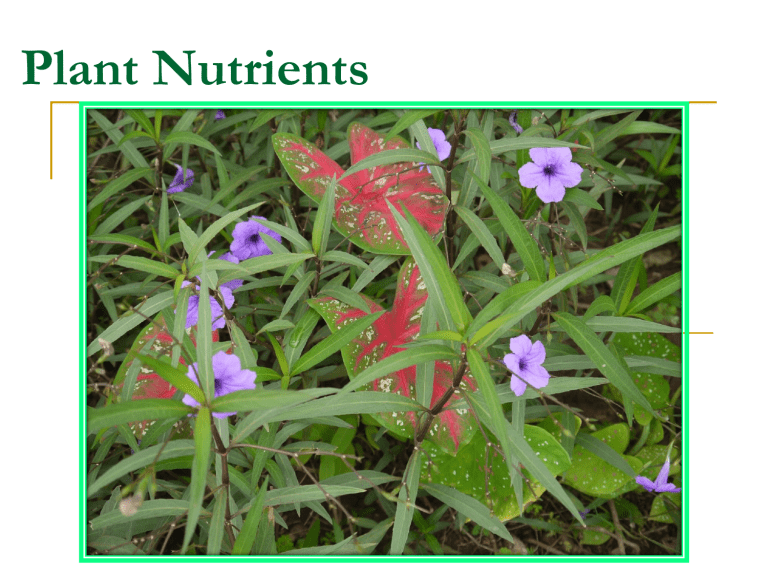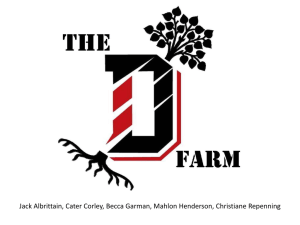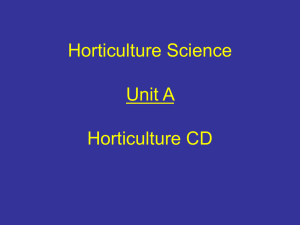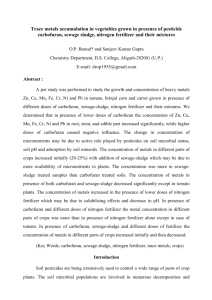PPT - Practical Farmers of Iowa

Plant Nutrients
Assessment of Nutrient Needs
•
Visual inspection of crops for deficiency symptoms
•
Damage could have occurred already
•
Symptoms may not be reliable
•
Soil tests to measure nutrient levels
•
Growers depend on this method to determine lime and fertilizer needs
•
Tissue testing for nutrients in plants
•
May uncover problems that soil test misses
Soil Testing
Soil sampling Soil testing
Soil Interpretation
Recommendation
Take a Good Soil Sample to Help Make Good Decisions
Taking a Soil Sample
Sampling Area
Should not exceed 10 acres
For row crops
Sampling Depth
Conventional tillage: 6-9 inches
Rotation field 2
Low
Spot
Rotation field 1
Permanent
Pasture
No till: Use special pH sample in top 2”
Sod or pasture: 2-3 inches
Tree Crops: 18-24 inches
Soil Test Results
pH: Acid, Neutral, Alkaline
Soil Test Rating: VL, L, M, H, VH, EH
(How much of a nutrient is available)
Soil Test Index: (How high or how low a nutrient is in the soil)
Soil Test
Rating
Very Low (H)
Low (L)
Medium (M)
High (H)
Very High (VH)
Soil Test
Index
0-50
60-70
80-100
110-200
210-400
Extremely High (EH) 410+
Explanation
Severe deficiency
Moderate deficiency
Near optimum: some fertilizer recommended
Adequate for most crops
Two to four times the amount considered adequate; none should be applied
Excessive; none should be applied
Phosphorus, Potassium, Magnesium, calcium
Additional Resources http://www.agron.iastate.edu/soiltesting/pm1714.pdf
(1) Nitrogen Fertilizer Recommendation for Corn in Iowa http://www.agron.iastate.edu/soiltesting/
(2) Iowa State University Soil Testing Lab www.extension.iastate.edu/store www.agronext.iastate.edu/soilfertility )
(3) Extension Publications.
Plant Food Elements
Used in Large Amounts
Macronutrients
Primary Nutrients Secondary
Nutrients
Nitrogen (N) Calcium (Ca)
Phosphorus (P)
Used in Small
Amounts
Micronutrients
Iron (Fe)
Magnesium (Mg) Manganese (Mn)
Potassium (K) Sulfur (S) Zinc (Zn)
Copper (Cu)
Boron (Bo)
Chlorine (Cl)
Cobalt (Co)
Nitrogen
•
Nitrogen is a primary component of proteins and is part of every living cell.
Functions of Nitrogen
•
Speeds growth
•
Vigorous growth, large leaves, and long stem internodes.
•
Required for the formation of dark green pigment: chlorophyll.
•
Promotes better production of chlorophyll hence it is required for better source of forage, feed and human nutrition.
•
Plants use water best when they have ample nitrogen.
Excess Nitrogen
• Soft, weak easily injured growth
Stems are weaker and more easily to lodge
•
Soft growth is more prone to diseases and insects
•
Overly rapid growth slows maturity and ripening of many crops
•
N promotes vegetative rather than reproductive growth of flowers and leaves.
•
Over-fertilized tomato plants promote lush growth but few fruits
Nitrogen deficiency
Slow growth and stunting
Plants lack dark green color of well fed plants: Chlorosis
Phosphorus
Functions
•
Phosphorus is part of chromosomes and genes and so it is involved in plant reproduction and cell division.
• P spurs early and rapid growth and helps a young plant develop its roots
•
P helps plants resist cold and diseases
•
P speeds up crop maturity
•
P aids blooming and fruiting
• P improves the quality of grains and fruits
Phosphorus Deficiency
There is stunted growth but plants could remain green.
Plants have a purple tint to leaves and stems, starting on lower
Older leaves
Potassium (Potash)
Functions
•
Activates enzymes needed in the formation of protein, starch cellulose and lignin.
•
It is important in the formation of thick cell walls and strong, rigid plant stems.
•
Regulates the opening and closing of pores in the leaf through which water, oxygen and carbon dioxide pass.
•
Important in the development and ripening of fruits like apples or tomatoes
•
Needed for proper growth of root and tuber crops
Potassium Deficiencies
Seen less often than the other primary nutrients.
Shortages occur primarily in sandy heavily leached soils.
“Marginal scorch” or burnt edges of lower, older leaves
Calcium
Secondary Nutrients
Functions of Calcium
•
Required by plants mainly to build cell wall
•
Crispness of apples come from calcium pectate in the fruit cells
•
Ca largely controls soil pH and helps in the formation of soil structure
•
Calcium plays a role in protein formation and carbohydrate movement in plants
Calcium Deficiencies
•
Commonly appear in fruits and vegetables.
• Apple growers prevent “water core” (collapse of cell walls) in apples by spraying trees with Ca.
• This is similar to “blossom end rot” in tomatoes.
Soil dries out and slows movement of Ca to roots during rapid root development.
•
Ca deficiency cause misshapen roots on root vegetables.
Functions of Magnesium
Magnesium
•
It is an essential ingredient in chlorophyll formation
Each chlorophyll molecule has one magnesium atom at the center
•
Magnesium activates a number of important enzyme systems
•
Mg is involved in protein, carbohydrates and fat synthesis
Sulfur
Functions of Sulfur
•
Needed in the formation of proteins and chlorophyll
•
Aids in the formation of nodules in legumes and seed production
•
S improves stress tolerance.
•
Alfalfa, members of the mustard family and members of the onion family need much sulfur.
• The pungent flavors derive from sulfur compounds
Sulfur Deficiencies
•
Stunted growth
• Older leaves are pale green – similar to N-deficient plants
Micronutrients
•
These form special organic-metal molecules called Enzymes.
Enzymes activate biological reactions in living systems.
•
The difference between enough and too much can be quite narrow, sometimes only a few pounds per acre
Please apply elements with caution
Effect of pH on nutrient availability
Iron
Functions of Iron
•
Iron is part of many enzymes necessary for the formation of chlorophyll
•
It is an abundant element in rocks and soils but it is also one of the most commonly deficient micronutrient
Symptoms of Iron Hunger
“Chlorosis”: Yellowing of interveinal leaves.
Mainly new leaves
Functions of Manganese
Manganese
•
Speeds up germination and crop maturity
•
Helps uptake of several other nutrients
•
Functions in chlorophyll development
Symptoms of Manganese Deficiency
•
Dwarfing
•
Chlorosis on new leaves
Zinc
Functions of Zinc
Needed in the metabolism of protein
Involved somehow in the production of chlorophyll
Symptoms of Zinc Deficiency
Fruit crops including peaches and citrus are sensitive to zinc deficiency
Field crops also include corn, soybeans, cotton, and potatoes
Symptoms include spots on leaves
Chlorosis between veins is also common
Fertilizers
Added to the soil to provide essential nutrients to plants
Fertilizer Material Chemical compounds or mixtures containing nutrient
•
•
Mixed fertilizer
Weed and Feed fertilizers
•
•
•
Liquid fertilizers
Fertilizer Spikes
Slow-release fertilizers
Fertilizer Grade: 13 - 13 - 13
%N
% Phosphate
(P
2
O
5
)
Some Popular Fertilizer Grades Available in Alabama
Fertilizer Grade % of all Grades sold in Alabama
13 - 13 - 13
8 - 24 - 24
8 - 8 - 8
5 - 10 - 15
7 - 21 - 21
5 - 15 - 30
18 - 46 - 0 (diammonium phosphate)
0 - 20 - 20
3 - 9 - 18
10 - 10 -10
15 - 0 - 15
5%
49%
7%
7%
7%
7%
6%
4%
4%
2%
<18%
Examples of Fertilizer Calculations
Recommendation:
120 Ib N, 60Ib Phosphate, 60 Ibs potash per acre
Fertilizer Grade: 13 - 13 - 13
Before Planting
60/13% percent = 461 pounds / acre of 13 - 13 - 13
Amount needed
Analysis of source
Size of Garden : 50 x 20 = 1,000 square feet
1 acre = 43, 000 square feet
1,000 square feet = 1,000 / 43,000 = 0.023 acres
Fertilizer needed = 0.023 x 461 pounds per acre = 0.6 Ib
Examples of Fertilizer Calculations
Recommendation:
120 Ib N, 60Ib Phosphate, 60 Ibs potash per acre
Fertilizer Grade: 13 - 13 - 13
Sidedressing
Use ammonium nitrate (34 - 0 - 0)
Amount needed per acre = 60 / 34% = 176 pounds
Size of Garden = 0.023 acres
Amount required for side dressing = 0.023 x 176 = 4 pounds
Recommendation:
“Per 50 ft x 20 ft garden apply 6 pounds of 8 - 8 - 8 at planting and sidedress with 4 pounds of 8 - 8 - 8”
Fertilizer Grade Available: 13 - 13 - 13
At Planting
6 Ib (expected) x 8 (required) / 13 (available ) = 3.7
Sidedressing
4 x 8 / 13 = 2.5 Ib, 13 - 13 - 13









